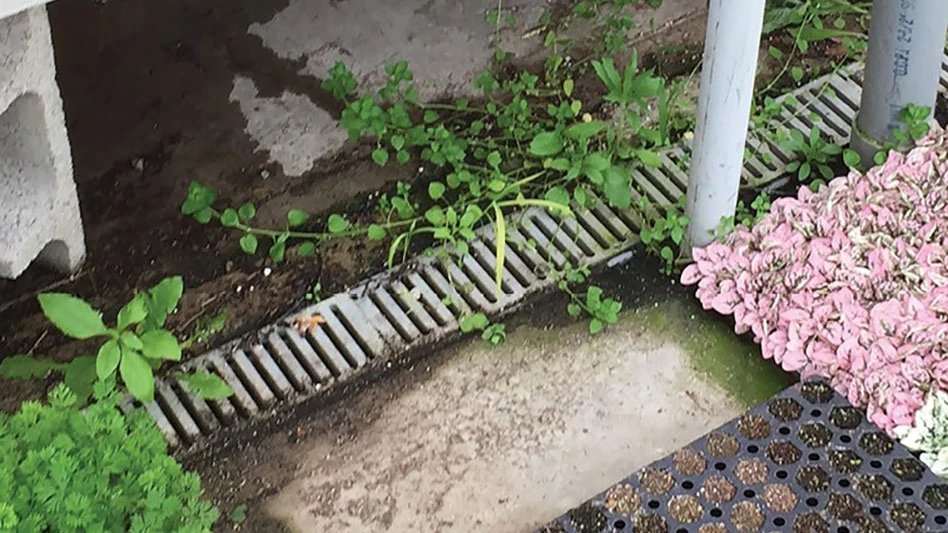

Sanitation is the first line of defense in any plant protection program and can reduce potential problems with insect and mite pests and diseases. The effectiveness of insecticides and miticides or biological control agents is contingent on implementing a stringent sanitation program.
Sanitation involves removing weeds, reducing algae and removing plant debris from both inside and outside the greenhouse facility.
Weeds
Weeds inside and outside the greenhouse provide refuge for insect and mite pests, such as aphids, leafminers, thrips, spider mites and whiteflies, allowing these pests to survive and disperse onto the main crop. Weeds that can serve as a refuge for insects include sowthistle, Sonchus spp. (aphids and whiteflies); oxalis, Oxalis spp. (thrips); and dandelion, Taraxacum officinale (whiteflies).
In addition, many weeds serve as reservoirs for pathogens, such as viruses that can be acquired by insects and then transmitted to the main crop during feeding. Consider installing landscape or fabric barriers underneath benches to help prevent weeds from emerging from the soil underneath benches and diminish algae growth. There are herbicides registered for use in and around greenhouses, although caution must be exercised when using herbicides inside greenhouses. A pre-emergent herbicide can be applied prior to weed emergence whereas a post-emergent herbicide can be applied after weeds emerge. However, be sure to avoid any inadvertent plant injury (phytotoxicity) when using herbicides, especially those that have systemic (when applied as a spray) and post-emergent activity, by making applications when greenhouses are empty. Always read the label directions before mixing and loading. Large weeds (6 inches tall) should be physically removed by hand, taking care to remove both the aboveground portion and the roots. Weed-free zones or areas around the outside perimeter of greenhouses (10 to 30 feet) can reduce the migration of insects, such as winged adults of western flower thrips (Frankliniella occidentalis), through openings, which decreases the potential incidence for disease transmission.
Algae
Algae provide an ideal breeding substrate for fungus gnats and shore flies; subsequently, algae must be reduced or eliminated from benches and floors. The practices of not over-watering and over-fertilizing plants and using well-drained growing media will definitely help to avoid problems with algae. Furthermore, reducing algae may be accomplished by using commercially available disinfectants such as those containing the following active ingredients: hydrogen peroxide, hydrogen dioxide and quaternary ammonium chloride salts. Another practice is routinely pressure-washing growing medium from benches and walkways, which will alleviate algae building-up and avoid having to deal with insect pests.
Debris
Plant debris, such as leaves, flowers and growing medium debris, provide refuge for certain insect and/or mite pests. Insects and even mites can migrate to fresh plant material as plant debris desiccates. For example, reports have shown that plant material and growing medium debris placed into unsealed refuse containers can be a source of insect pests. As plant material desiccates, adults can migrate onto the main crop. Therefore, always place debris into refuse containers with tight-sealing lids. Also, any leftover growing medium provides sites for fungus gnat (Bradysia spp.) adults to lay eggs and western flower thrips to pupate. Use a broom or shop-vacuum to remove plant or growing medium debris. Moreover, old stock plants or those remaining at the end of the growing season should be removed because they can be a potential source of insect and mite pests. Old stock plants can also serve as reservoirs for the viruses transmitted by insects such as the western flower thrips. Another important sanitation practice is to immediately remove any plants heavily infested with insect or mite pests from the greenhouse.

Explore the September 2022 Issue
Check out more from this issue and find your next story to read.
Latest from Greenhouse Management
- Anthura acquires Bromelia assets from Corn. Bak in Netherlands
- Top 10 stories for National Poinsettia Day
- Langendoen Mechanical hosts open house to showcase new greenhouse build
- Conor Foy joins EHR's national sales team
- Pantone announces its 2026 Color of the Year
- Syngenta granted federal registration for Trefinti nematicide/fungicide in ornamental market
- A legacy of influence
- HILA 2025 video highlights: John Gaydos of Proven Winners





